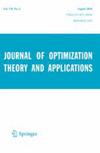多项式互补问题解的边界
IF 1.5
3区 数学
Q2 MATHEMATICS, APPLIED
Journal of Optimization Theory and Applications
Pub Date : 2024-08-23
DOI:10.1007/s10957-024-02511-5
引用次数: 0
摘要
多项式互补问题(PCP)是张量互补问题(TCP)的重要扩展。本文的主要目的是将徐谷黄关于 TCP 解的边界的结果从 TCP 扩展到 PCP。为此,本文扩展了(广义)行严格对角显性张量到张量元组的概念,并讨论了它们的相关性质。通过使用引入的结构张量元组,推导出了 PCP 解的规范上界和下界。本文提出的结果与现有的界限进行了比较。本文章由计算机程序翻译,如有差异,请以英文原文为准。
The Bounds of Solutions to Polynomial Complementarity Problems
The polynomial complementarity problem (PCP) is an important extension of the tensor complementarity problem (TCP). The main purpose of the present paper is to extend the results on the bounds of solutions of TCP due to Xu–Gu–Huang from TCP to PCP. To that end, the concepts of (generalized) row strictly diagonally dominant tensor to tensor tuple are extended and the properties about them are discussed. By using the introduced structured tensor tuples, the upper and lower bounds on the norm of solutions to PCP are derived. Comparisons between the results presented in the present paper and the existing bounds are made.
求助全文
通过发布文献求助,成功后即可免费获取论文全文。
去求助
来源期刊
CiteScore
3.30
自引率
5.30%
发文量
149
审稿时长
9.9 months
期刊介绍:
The Journal of Optimization Theory and Applications is devoted to the publication of carefully selected regular papers, invited papers, survey papers, technical notes, book notices, and forums that cover mathematical optimization techniques and their applications to science and engineering. Typical theoretical areas include linear, nonlinear, mathematical, and dynamic programming. Among the areas of application covered are mathematical economics, mathematical physics and biology, and aerospace, chemical, civil, electrical, and mechanical engineering.

 求助内容:
求助内容: 应助结果提醒方式:
应助结果提醒方式:


